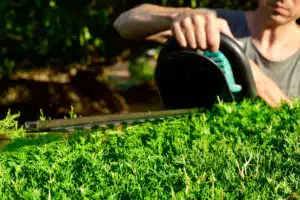*HALF PRICE BLACK FRIDAY SALE ON NOW*
ORDER ONLINE OR CALL OUR FRIENDLY TEAM ON 01580 765600
Menu
*HALF PRICE BLACK FRIDAY SALE ON NOW*
ORDER ONLINE OR CALL OUR FRIENDLY TEAM ON 01580 765600
You are here: Home »

Leylandii are a great hedging and screening plant but there is one important thing to remember – they will not re grow if you cut back into the old wood. Once it is brown, it will stay brown and there is no way of remedying this as Leylandii hedges have little or no ability to regenerate from the old wood.
If you are going to keep a Leylandii hedge in good order and not too tall or wide, then it is essential to trim it at least once a year. This will ensure that you are only ever cutting into the new green growth and the hedge will therefore still look nice and green (as well as tidy!) after you have cut it, with no brown patches.
For a new hedge the first trimming will probably involve no more than taking the tips out of any long side growths, for a really dense hedge from the start it is worth sacrificing some height by cutting the tops back, the plants will grow back really quickly and will be far bushier for it.
Once your Leylandii hedge is well established its worth bearing in mind that even if you do trim once a year, the amount of clippings this vigorous hedge produces will be substantial. If this is likely to be a problem, or there is a chance you may not be able to cut it every year then we would recommend you consider a slower growing alternative. We have a number of other conifer hedging species including various types of Thuja and also English Yew, as well as being slower growing they also regenerate when cut back into old wood which can be really useful if your hedge does get out of hand. You could check out our complete range of conifer hedging and screening or consider alternatives from our evergreen hedging page.
If you trim a Leylandii hedge more than once a year, it is possible to get a true ‘show garden’ look, very neat, crisp and precise – more like a Yew hedge but much faster growing! Frequently trimmed Leylandii hedges can look very fine indeed, especially in a garden setting – and there are far fewer clippings to clear up and dispose of afterwards.
However often you choose to cut your Leylandii hedge and whether you use shears or a hedge trimmer, do make sure that they are sharp. Blunt cutting tools will cause unnecessary damage to the growth that remains on the hedge making it easier for fungal spores or other pests and diseases to gain a foothold and infect your hedge.
While there is no hard and fast rule about which time of year is best to trim a Leylandii hedge, there are a few basic rules: